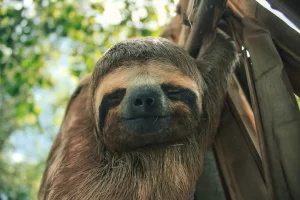
Photo by David Gomez on Unsplash
Conventional wisdom often casts sloths as lazy, simple creatures, drifting through life with little purpose beyond sleeping. The very name ‘sloth’ has become synonymous with idleness, and in 1749, French naturalist Buffon described them as slow, habitually in pain, and unintelligent, calling them the “lowest form of existence.” This harsh judgement, echoed throughout history, stems from a fundamental misunderstanding of the sloth’s way of life — a misunderstanding that reflects how we often misjudge not only animals but also each other.
Today, in a world full of gurus, coaches, therapists, and Instagram teachers, we are constantly bombarded with advice on how to live our lives, be productive, and overcome our flaws. These voices often tell us what to do and how to be, overlooking a key factor: the unconscious intelligence that drives much of our behaviour. This unconscious wisdom often knows what it is doing, even when we consciously do not. The story of the sloth offers a reflection on this very idea.
Sloths, often mocked for their slow movement and algae-covered fur, have a reputation for being inefficient or even unintelligent. For example, their habit of descending to the ground to defecate, exposing themselves to predators like jaguars, seems like a foolish risk. However, this ritual is actually vital for reproduction. Female sloths use this time to leave signals for potential mates and gather information about others in the area. What seems irrational or dangerous to an outside observer is, in fact, a deeply ingrained survival strategy, guided by the sloth’s unconscious instincts.
This speaks to a larger truth: just as the sloth’s actions are guided by its evolutionary intelligence, human behaviour is also shaped by our unconscious minds. Much of what we do, whether in personal life or therapy, stems from processes we don’t fully understand. While experts may offer advice based on surface-level observations, the unconscious forces within each individual often know more than any external teacher or guide.
A Therapeutic Example: Trusting the Unconscious
Consider a typical therapy session where a client feels stuck, unable to explain why they haven’t been able to make the changes they so desperately want. They might come to therapy seeking clarity, frustrated by their perceived inaction or emotional paralysis. Traditional therapeutic approaches often focus on analysing these blocks and pushing toward immediate solutions. But this approach can overlook the wisdom of the unconscious.
For instance, I once worked with a client who had difficulty making decisions regarding a major life change — a new job opportunity in a different city. On the surface, it seemed like the perfect step: better pay, new challenges, and a fresh start. Yet the client kept delaying the decision and felt immense guilt for not moving forward. External voices — from career coaches to friends — urged quick action, framing the delay as indecisiveness or fear of change.
However, when we explored the situation more deeply in therapy, it became clear that the client’s hesitation was not due to laziness or fear but a deep, unconscious awareness that something was off. Their body and emotions were signalling caution, even though their conscious mind couldn’t articulate why. Over time, the client realised that taking the job would actually bring more stress and disconnection from their family, things that deeply mattered but were initially overlooked in the excitement of the opportunity.
Like the sloth’s seemingly irrational movements, this client’s unconscious mind knew what it was doing. The delay was not a flaw but a protective mechanism, ensuring that they made a decision aligned with their values and deeper emotional needs. Once they understood this, they were able to make an informed choice — one that respected both their conscious goals and unconscious wisdom.
Conclusions: Lessons from Sloths and the Power of Unconscious Intelligence
Sloths teach us profound lessons about survival, perception, and the nature of intelligence. They remind us that judgements based on appearances — whether of animals or people — often miss the deeper, unseen forces at play. Like the sloth, we too possess an unconscious intelligence, a force that operates beneath the surface, guiding our actions and decisions even when we’re not fully aware of it. This is a critical aspect of being human, and one that is frequently overlooked, especially in today’s world, where experts abound, each offering a prescription for how we should live.
- Unconscious intelligence is wiser than we think.
Just as sloths instinctively know how to survive, we too have an inner wisdom that guides us, even when we don’t consciously understand it; we often call this a ‘gut feeling’. Just like a sloth descending a tree or a person hesitating over a decision, our unconscious often knows what it’s doing, even when gurus, coaches, or therapists may not. People’s judgements — including those of experts — are limited by their own perceptions. They do not have access to this inner intelligence that each of us carries. - Hesitation or delay can be a form of self-preservation.
Just as sloths move slowly to conserve energy, delays or indecision in humans may be a protective mechanism. In therapy, clients often feel frustrated by their inability to move forward, but sometimes this delay reflects a deeper, unconscious intelligence guiding them toward a decision that is more aligned with their emotional needs or values. Taking the time to listen to this inner wisdom can prevent unnecessary harm or regret.
Dear reader, I know what you are thinking: What if it’s a maladaptive behaviour or habit, mistaken for a gut instinct?
This raises an important question about the fine line between trusting our inner world and recognising when certain behaviours, especially maladaptive ones, stem from trauma or unconscious conditioning rather than genuine instincts.
In my view, much of what we perceive as instinctive behaviour may in fact be learned survival strategies, ingrained during formative years when we had to protect ourselves from emotional pain or unmet needs. These behaviours, though adaptive at the time, can become maladaptive in adulthood when the context has changed. What once served to shield us from harm may now keep us trapped in cycles of avoidance, addiction, or self-sabotage.
I know you want an example. Okay, take, for instance, someone who feels a gut instinct to withdraw from intimate relationships. To the individual, this might feel like self-protection, an instinct telling them that vulnerability is dangerous. Yet, if we look deeper, we might find a history of abandonment or rejection, where emotional closeness once equated to pain. In such cases, the “gut instinct” is not a genuine guide to one’s needs, but rather a trauma response — an unconscious effort to avoid further hurt.
The work, then, is not to dismiss our instincts outright, but to inquire into them with curiosity and compassion. Is this behaviour truly in alignment with my authentic self, or is it a vestige of past survival mechanisms? True healing begins when we can distinguish between genuine instincts, which move us toward growth and connection, and conditioned responses, which are rooted in fear and avoidance.
A therapist should serve as a guide in this exploration, not as a judge of behaviour. It is their role to help us identify where we are being guided by past wounds rather than present reality. Through compassionate inquiry, a good therapist will support us in reconnecting with our authentic selves, so that we may make choices not from a place of survival, but from a place of inner wisdom.
3. Success is not always about speed.
In a fast-paced world, the sloth shows us the wisdom of slowing down. Sloths have survived for millions of years by adapting to their environment at a slow pace. Likewise, in therapy, rushing toward solutions may overlook the deeper process of emotional integration that needs time to unfold. Trusting the slower, unconscious processes can often lead to more lasting and meaningful outcomes.
4. Nature’s adaptations are brilliant, even when misunderstood.
Sloths camouflage themselves with algae, moving so slowly that even predators fail to notice them. This brilliant adaptation reflects the deeper intelligence of nature, which operates beyond human comprehension. Similarly, think of animals that sleep longer during winter, like bears in hibernation. What may seem like prolonged inactivity is actually a vital period of conservation and restoration, allowing them to thrive when the conditions are right. In the same way, what might look like indecision or delay in a client could actually be their unconscious mind adapting to complex emotional realities, ensuring they take action only when they are truly ready and able. I imagine that if a bear went to see a GP in winter, they’d be prescribed some tablets to overcome hibernation!
Let’s have a bit of fun now by imagining a dialogue between Buffon, the French naturalist who described sloths as slow, unintelligent, and habitually in pain, and one of the very sloths from which he drew his conclusions:
Buffon
“Ah, my dear sloth, I’ve been observing you for quite some time, and I must say, your lifestyle leaves much to be desired. You’re slow, inefficient, and, frankly, a bit uninspired. Allow me to prescribe a simple, intelligent plan for you to follow: First, break your day into small, manageable tasks. Climb one branch at a time, quickly! Set a timer — 5 minutes per branch should do the trick. Eliminate distractions, of course. No more staring off into the jungle for hours. And when you’ve accomplished each task, reward yourself. Perhaps a leaf snack! What do you think?”
Sloth:
“Hmm, well, Monsieur Buffon, that’s quite the plan. I’m sure it works…. But let’s see here — 5 minutes per branch? I move a grand total of about 10 feet per day. By the time your timer rings, I’ll have barely stretched out my claw! And as for distractions, staring into the jungle is my version of ‘zen,’ my friend. Plus, I don’t need rewards for each task — life is my reward! I’ve been around for 64 million years without timers or task lists, thriving in slow motion. So, thank you for the suggestion, but I think I’ll stick to my ‘unintelligent’ ways. They seem to be working just fine for me!”
In conclusion, I am sceptical of ‘overcome procrastination’ programs, which often offer a one-size-fits-all solution that ignores the complexity of human behaviour. These programs, along with self-help coaches and gurus, frame procrastination, avoidance, laziness, or lack of motivation as problems to be fixed, pushing for constant productivity without recognising the deeper purpose these behaviours might serve.
Procrastination and avoidance can be forms of unconscious self-regulation — a way for the mind to process complex emotions or cope with overstimulation. In today’s world, we are bombarded by sensory input, spend long hours in highly stimulating environments, and often lack sufficient rest. What appears as laziness or a lack of motivation may, in fact, be a necessary pause, allowing us to slow down and process the overwhelm.
As Carl Jung so insightfully said, “Your unconscious knows more than you do. It is a powerful force that is continuously and silently at work, guiding your actions and choices.” Of course, Buffon did not know this, as his rational mind rushed to conclusions.


